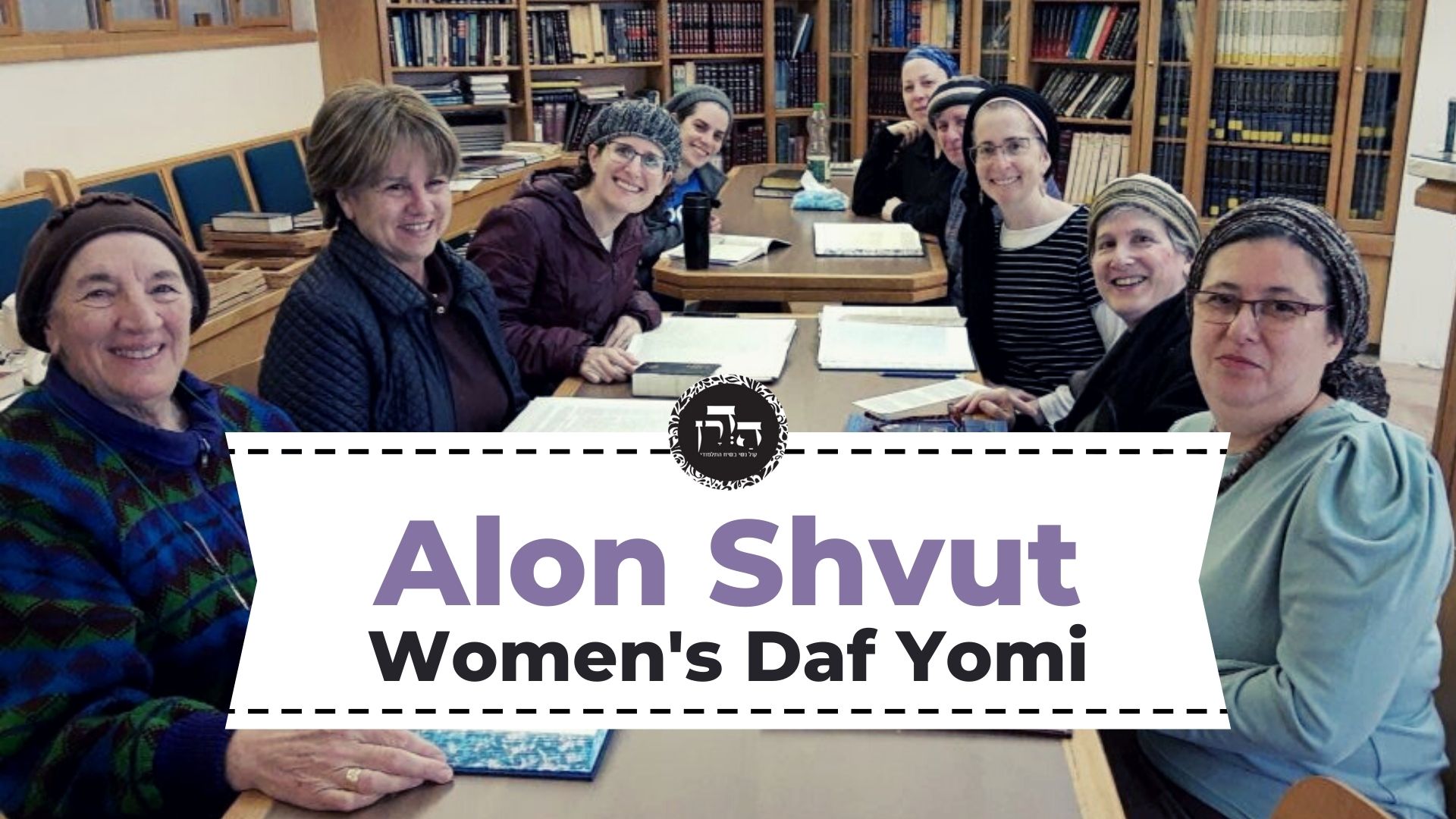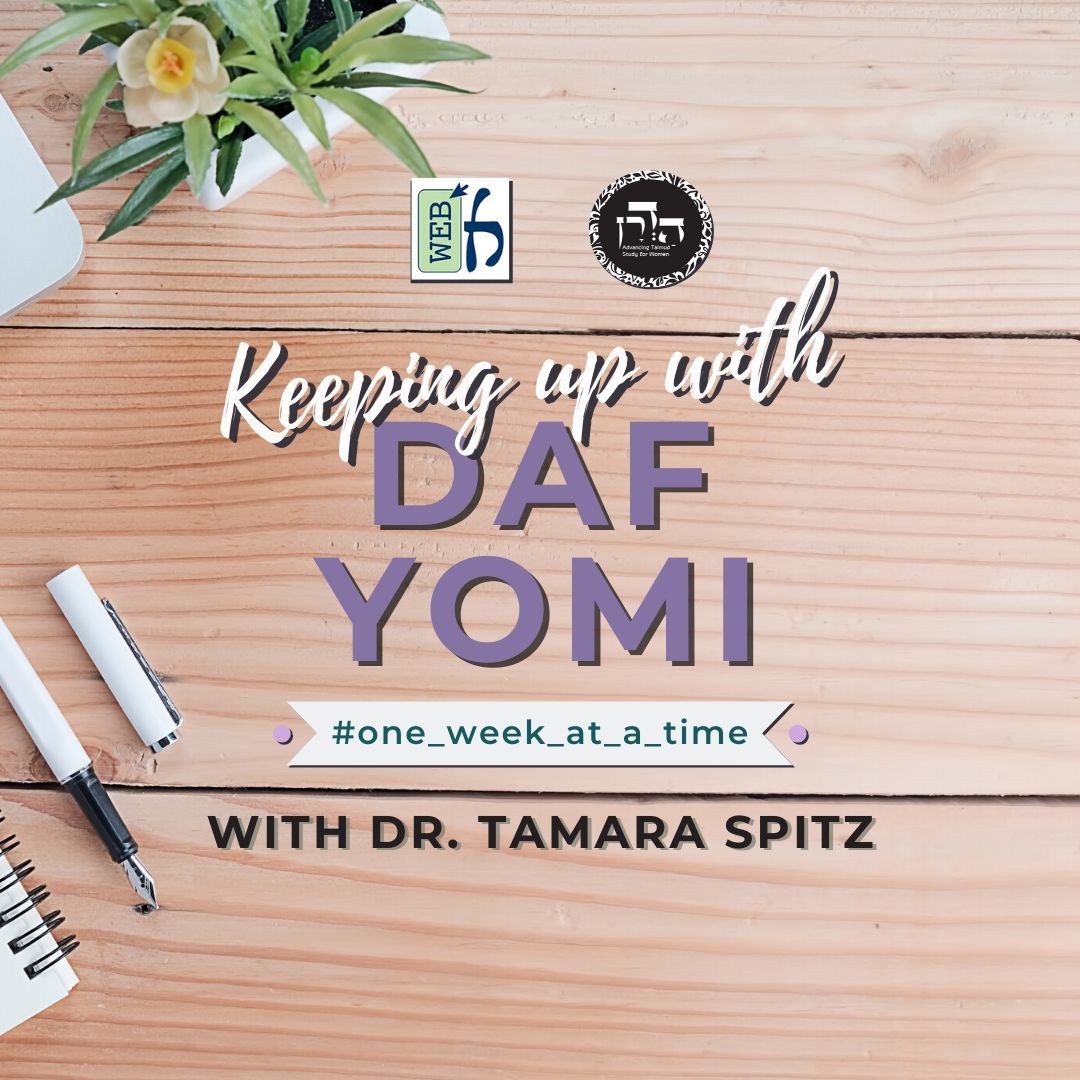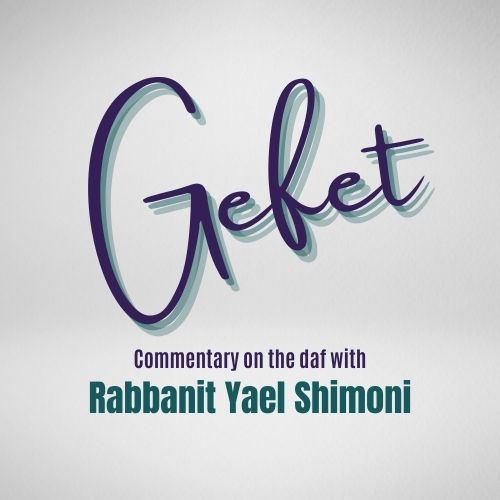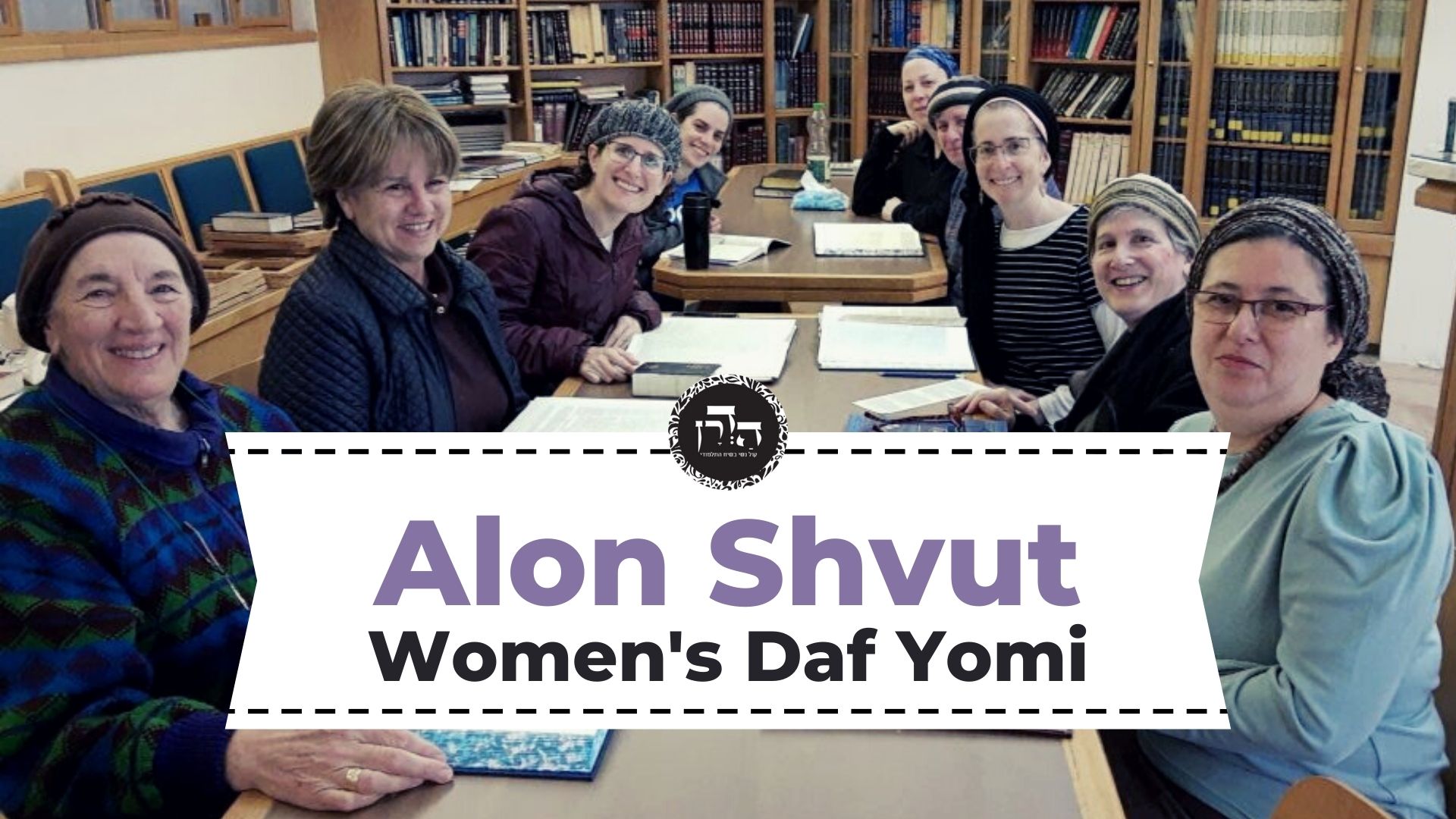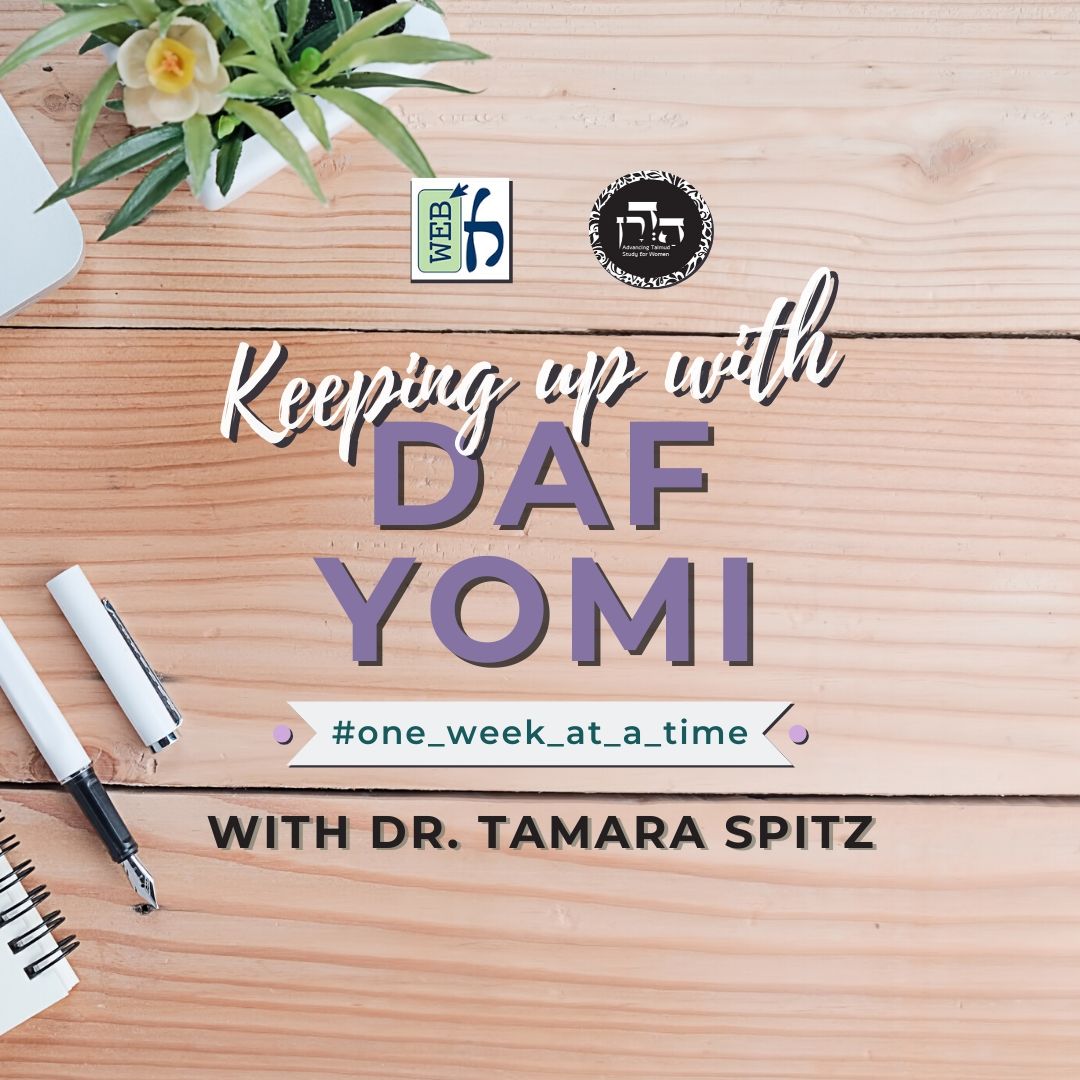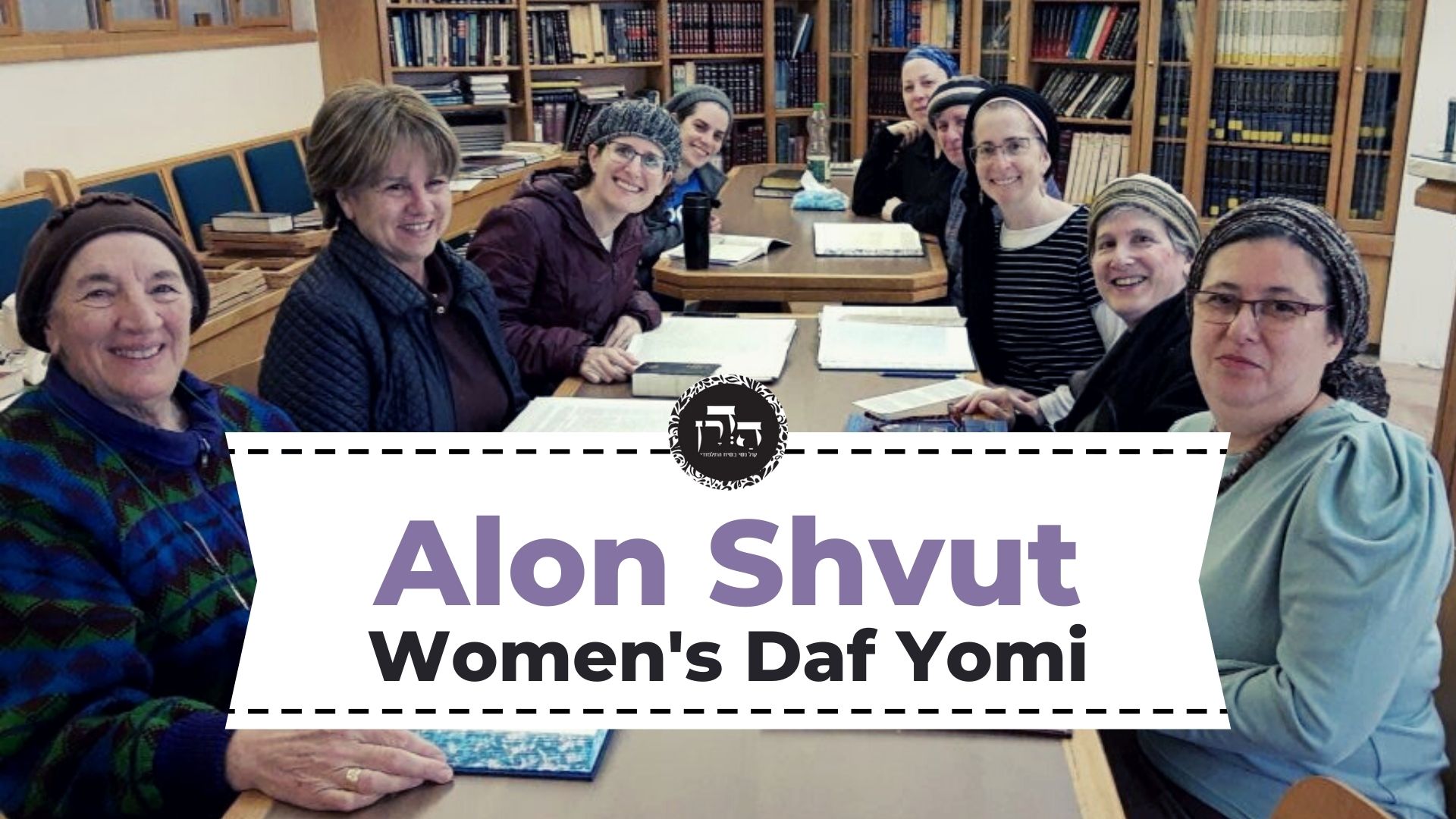Various laws regarding tefillin are detailed.
This week’s learning is sponsored by Robert and Paula Cohen in loving memory of Joseph Cohen, Yosef ben Moshe HaCohen, z”l. “He was hard working, loved to sing, esp. as a chazan, and was very dedicated to his family and community.”
Want to dedicate learning? Get started here:

Today’s daily daf tools:
This week’s learning is sponsored by Robert and Paula Cohen in loving memory of Joseph Cohen, Yosef ben Moshe HaCohen, z”l. “He was hard working, loved to sing, esp. as a chazan, and was very dedicated to his family and community.”
Today’s daily daf tools:
Delve Deeper
Broaden your understanding of the topics on this daf with classes and podcasts from top women Talmud scholars.
New to Talmud?
Check out our resources designed to help you navigate a page of Talmud – and study at the pace, level and style that fits you.
The Hadran Women’s Tapestry
Meet the diverse women learning Gemara at Hadran and hear their stories.
Menachot 35
אֶלָּא גַּוָּיְיתָא לְבָרַיְיתָא וּבָרַיְיתָא לְגַוָּיְיתָא, אֲבָל גַּוָּיְיתָא לְגַוָּיְיתָא וּבָרַיְיתָא לְבָרַיְיתָא – לֵית לַן בַּהּ.
unless it is a case where one exchanges an inner passage for an outer one, e.g., he placed the passage of Exodus 13:11–16 to the right of Exodus 13:1–10, or an outer passage for an inner one, e.g., he placed the passage of Deuteronomy 11:13–21 to the right of Deuteronomy 6:4–9. But if one exchanges an inner passage for the other inner one, i.e., he exchanges Exodus 13:11–16 with Deuteronomy 6:4–9, or an outer passage for the other outer one, i.e., he exchanges Exodus 13:1–10 with Deuteronomy 11:13–21, we have no problem with it.
אֲמַר לֵיהּ רָבָא: מַאי שְׁנָא גַּוָּיְיתָא לְבָרַיְיתָא וּבָרַיְיתָא לְגַוָּיְיתָא דְּלָא, דְּהָךְ דְּבָעֵי לְמִיחְזֵי אַוֵּירָא לָא קָא חָזְיָיא, וְהָא דְּלָא קָא בָעֵי לְמִיחְזֵי אַוֵּירָא קָא חָזְיָיא? בָּרַיְיתָא לְבָרַיְיתָא וְגַוָּיְיתָא לְגַוָּיְיתָא נָמֵי – הָךְ דְּבָעֲיָא לְמִיחְזֵי אַוֵּירָא דְּיָמִין קָא חָזְיָא אַוֵּירָא דִּשְׂמֹאל, וְדִשְׂמֹאל קָא חָזְיָא אַוֵּירָא דְּיָמִין! אֶלָּא לָא שְׁנָא.
Rava said to Abaye: What is different about the cases of exchanging an inner passage for an outer one, and an outer passage for an inner one, such that the phylacteries are not fit? The reason is that this passage, which needs to see the air, i.e., to be placed on the outer side, does not see it, and that passage, which does not need to see the air, does see it. But in a case where one exchanges an outer passage for the other outer one or an inner passage for the other inner one, it should be unfit as well, as this passage, which needs to see the air of the right side, sees the air of the left side, and that passage, which requires to see the air of the left side, sees the air of the right side. Rather, there is no difference between any of these cases, and any change in the order renders the phylacteries unfit.
וְאָמַר רַב חֲנַנְאֵל, אָמַר רַב: תִּיתּוּרָא דִּתְפִילִּין הֲלָכָה לְמֹשֶׁה מִסִּינַי. אָמַר אַבָּיֵי: מַעְבַּרְתָּא דִּתְפִילִּין הֲלָכָה לְמֹשֶׁה מִסִּינַי. וְאָמַר אַבָּיֵי: שִׁי״ן שֶׁל תְּפִילִּין הֲלָכָה לְמֹשֶׁה מִסִּינַי.
§ And Rav Ḥananel says that Rav says: The requirement to have the titora of phylacteries, i.e., the base of phylacteries upon which the compartments rest, is a halakha transmitted to Moses from Sinai. Abaye said: The requirement to have the ma’ebarta of phylacteries, i.e., the passageway through which the straps are inserted, is a halakha transmitted to Moses from Sinai. And Abaye says: The requirement to have a letter shin protruding on the phylacteries of one’s head, which is achieved by pressing the hide into the shape of that letter, is a halakha transmitted to Moses from Sinai.
וְצָרִיךְ שֶׁיַּגִּיעַ חָרִיץ לִמְקוֹם הַתֶּפֶר, רַב דִּימִי מִנְּהַרְדְּעָא אָמַר: כֵּיוָן דְּמִנְּכַר, לָא צְרִיךְ.
Abaye further says: And there is a requirement that the furrow between each of the compartments of phylacteries of the head reach the place of the stitches, i.e., the titora, to which the compartments are sewn. Rav Dimi of Neharde’a says: Once it is noticeable that there is a furrow between each of the compartments, it is not necessary for them to reach all the way to the titora.
וְאָמַר אַבָּיֵי: הַאי קִילְפָּא דִּתְפִילִּין צָרִיךְ לְמִיבְדְּקֵיהּ, דְּדִילְמָא אִית בַּהּ רֵיעוּתָא, וּבָעֵינָא כְּתִיבָה תַּמָּה וְלֵיכָּא. רַב דִּימִי מִנְּהַרְדְּעָא אָמַר: לָא צְרִיךְ, קוּלְמוֹסָא בָּדֵיק לַהּ.
And Abaye says: With regard to this parchment upon which one writes the passages of phylacteries, the scribe must examine it before writing, as perhaps it has a flaw, i.e., a perforation, and complete writing is required, and that requirement would not be fulfilled if a letter were perforated. Rav Dimi of Neharde’a says: No prior examination is required; rather, the quill examines it as one writes, as any perforation which the ink covers is disregarded.
אָמַר רַבִּי יִצְחָק: רְצוּעוֹת שְׁחוֹרוֹת הֲלָכָה לְמֹשֶׁה מִסִּינַי. מֵיתִיבִי: תְּפִילִּין אֵין קוֹשְׁרִין אוֹתָן אֶלָּא בְּמִינָן, בֵּין יְרוּקּוֹת בֵּין שְׁחוֹרוֹת בֵּין לְבָנוֹת, אֲדוּמּוֹת לֹא יַעֲשֶׂה, מִפְּנֵי גְּנַאי וְדָבָר אַחֵר.
Rabbi Yitzḥak says: The requirement that the straps of the phylacteries be black is a halakha transmitted to Moses from Sinai. The Gemara raises an objection from a baraita: One may tie phylacteries only with straps of their same type, i.e., the straps must be made from hide, and it does not matter whether they are green, or black, or white. Nevertheless, one should not make red straps, because this is deprecatory to him, as it looks like he has wounds on his head, and also due to something else, i.e., lest people suspect him of engaging in sexual intercourse with a menstruating woman and getting blood on the straps.
אָמַר רַבִּי יְהוּדָה: מַעֲשֶׂה בְּתַלְמִידוֹ שֶׁל רַבִּי עֲקִיבָא שֶׁהָיָה קוֹשֵׁר תְּפִילָּיו בִּלְשׁוֹנוֹת שֶׁל תְּכֵלֶת, וְלָא אָמַר לוֹ דָּבָר. אִיפְשָׁר אוֹתוֹ צַדִּיק רָאָה תַּלְמִידוֹ וְלֹא מִיחָה בּוֹ? אָמַר לוֹ: הֵן, לֹא רָאָה אוֹתוֹ, וְאִם רָאָה אוֹתוֹ לֹא הָיָה מַנִּיחוֹ.
The Gemara cites the continuation of that baraita. Rabbi Yehuda said: There was an incident involving Rabbi Akiva’s student, who would tie his phylacteries with strips of sky–blue wool rather than hide, and Rabbi Akiva did not say anything to him. Is it possible that that righteous man saw his student doing something improper and he did not object to his conduct? Another Sage said to Rabbi Yehuda: Yes, it is possible that the student acted improperly, as Rabbi Akiva did not see him, and if he had seen him, he would not have allowed him to do so.
מַעֲשֶׂה בְּהוּרְקָנוֹס בְּנוֹ שֶׁל רַבִּי אֱלִיעֶזֶר בֶּן הוּרְקָנוֹס, שֶׁהָיָה קוֹשֵׁר תְּפִילָּיו בִּלְשׁוֹנוֹת שֶׁל אַרְגָּמָן, וְלֹא אָמַר לוֹ דָּבָר. אִיפְשָׁר אוֹתוֹ צַדִּיק רָאָה בְּנוֹ וְלֹא מִיחָה בּוֹ? אָמְרוּ לוֹ: הֵן, לֹא רָאָה אוֹתוֹ, וְאִם רָאָה אוֹתוֹ לֹא הָיָה מַנִּיחוֹ.
The baraita continues: There was an incident involving Hyrcanus, the son of Rabbi Eliezer ben Hyrcanus, who would tie his phylacteries with strips of purple wool, and his father did not say anything to him. Is it possible that that righteous man saw his son doing something improper and he did not object to his conduct? The Sages said to him: Yes, it is possible that his son acted improperly, as Rabbi Eliezer did not see him, and if he had seen him, he would not have allowed him to do so. This concludes the baraita.
קָתָנֵי מִיהָא, בֵּין יְרוּקּוֹת בֵּין שְׁחוֹרוֹת וּבֵין לְבָנוֹת. לָא קַשְׁיָא: כָּאן – מִבִּפְנִים, כָּאן – מִבַּחוּץ.
The Gemara explains the objection from the baraita: In any event, the baraita teaches that it does not matter whether the straps are green, or black, or white, whereas Rabbi Yitzḥak maintains that it is a halakha transmitted to Moses from Sinai that the straps of the phylacteries must be black. The Gemara answers that it is not difficult. Here, the baraita is referring to the inside of the straps, which touch the body. These may be any color other than red. Conversely, there, when Rabbi Yitzḥak says that the straps of the phylacteries must be black, he is speaking of the outside of the straps.
אִי מִבִּפְנִים, מַאי גְּנַאי וְדָבָר אַחֵר אִיכָּא? זִימְנִין דְּמִתְהַפְכִין לֵיהּ.
The Gemara raises a difficulty: If the baraita is discussing the inside of the straps, what deprecatory matter or problem of something else is there with straps that are red on the inside? After all, this side is not seen. The Gemara answers: Sometimes his straps become reversed, and therefore these concerns are applicable.
תָּנָא: תְּפִילִּין מְרוּבָּעוֹת – הֲלָכָה לְמֹשֶׁה מִסִּינַי. אָמַר רַב פָּפָּא: בְּתִפְרָן וּבַאֲלַכְסוֹנָן.
It is taught in a baraita: The requirement that phylacteries be square is a halakha transmitted to Moses from Sinai. Rav Pappa says about this halakha: Square means along their seams and their diagonals, i.e., they must be perfectly square where the compartments are sewn to the titora.
לֵימָא מְסַיַּיע לֵיהּ: הָעוֹשֶׂה תְּפִילָּתוֹ עֲגוּלָּה – סַכָּנָה וְאֵין בָּהּ מִצְוָה. אָמַר רַב פָּפָּא: מַתְנִיתִין דַּעֲבִידָא כִּי אַמְגּוּזָא.
The Gemara suggests: Let us say that a mishna supports this opinion (Megilla 24b): One who fashions his phylacteries in a round shape exposes himself to danger, and it does not enable him to fulfill the mitzva of phylacteries. Rav Pappa said: This is no support, as one can say that the mishna is referring to phylacteries that are fashioned like a nut, i.e., their underside is rounded, and therefore there is a danger that if he strikes his head on a wall the underside will press into his head and injure him. By contrast, if the underside is flat one might have thought that it is fit despite the fact that it is not square. Therefore, the baraita teaches that phylacteries must be square.
אָמַר רַב הוּנָא: תְּפִילִּין, כָּל זְמַן שֶׁפְּנֵי טַבְלָא קַיֶּימֶת – כְּשֵׁירוֹת. רַב חִסְדָּא אָמַר: נִפְסְקוּ שְׁתַּיִם – כְּשֵׁירוֹת, שָׁלֹשׁ – פְּסוּלוֹת.
§ Rav Huna says: With regard to phylacteries of the head, as long as the surface of outer hide is intact, i.e., it is not torn, they are fit, even if the hide between the compartments has torn. Rav Ḥisda says: If two of the walls between the compartments tore, such phylacteries are fit, but if three of these inner walls tore, they are unfit.
אָמַר רָבָא: הָא דְּאָמְרַתְּ שְׁתַּיִם כְּשֵׁירוֹת, לָא אֲמַרַן אֶלָּא זֶה שֶׁלֹּא כְּנֶגֶד זֶה, אֲבָל זֶה כְּנֶגֶד זֶה – פְּסוּלוֹת. וְזֶה כְּנֶגֶד זֶה נָמֵי לָא אֲמַרַן אֶלָּא בְּחַדְתָּתָא, אֲבָל בְּעַתִּיקָתָא לֵית לַן בַּהּ.
Rava said: Concerning that which you said, that if two of the walls between the compartments tore they are fit, we said this only if the inner walls that tore are not aligned with each other, i.e., they are not adjacent to one another. But if the torn walls are aligned with each other, the phylacteries are unfit. And furthermore, even in a case where the torn walls are aligned with each other, we said that they are unfit only with regard to new phylacteries, as the hide is certainly defective. But with regard to old phylacteries, we have no problem with it, as they tore due to aging.
אֲמַר לֵיהּ אַבָּיֵי לְרַב יוֹסֵף: הֵיכִי דָּמְיָין חַדְתָּתָא, וְהֵיכִי דָּמְיָין עַתִּיקָתָא? אֲמַר לֵיהּ: כֹּל הֵיכָא כִּי מִיתְּלֵי בֵּיהּ בְּשִׁלְחָא וַהֲדַר חָלֵים – עַתִּיקָתָא, וְאִידַּךְ – חַדְתָּתָא.
Abaye said to Rav Yosef: What are the circumstances of new phylacteries, and what are the circumstances of old phylacteries? Rav Yosef said to him: In any case where if one holds the hide and pulls it, it returns to its place [ḥaleim], these phylacteries are considered old; and in the other case, where hide that was pulled does not return to its place, they are considered new.
וְאִי נָמֵי כֹּל הֵיכִי דְּכִי מִיתְּלֵי בֵּיהּ בְּמִתְנָא אַתְיֵיהּ אַבָּתְרֵיהּ – חַדְתָּתָא, וְאִידָּךְ – עַתִּיקָתָא.
Alternatively, in any case where if the phylacteries are hanging by the strap the compartment follows the strap, i.e., it remains attached, these phylacteries are considered new; and in the other case, where the phylacteries would fall off, they are considered old.
אַבָּיֵי הֲוָה יָתֵיב קַמֵּיהּ דְּרַב יוֹסֵף, אִיפְּסִיק לֵיהּ רְצוּעָה דִּתְפִילֵּי, אֲמַר לֵיהּ: מַהוּ לְמִיקְטְרֵיהּ? אֲמַר לֵיהּ: ״וּקְשַׁרְתָּם״ כְּתִיב, שֶׁתְּהֵא קְשִׁירָה תַּמָּה.
§ The Gemara relates: Abaye was sitting before Rav Yosef when the strap of his phylacteries tore. Abaye said to Rav Yosef: What is the halakha as to whether one may tie the strap? Rav Yosef said to him: It is written with regard to phylacteries: “And you shall bind them [ukshartam] for a sign upon your arm” (Deuteronomy 6:8), which teaches that the binding must be complete [keshira tamma], whole and beautiful, and that would not be the case with a makeshift knot.
אֲמַר לֵיהּ רַב אַחָא בְּרֵיהּ דְּרַב יוֹסֵף לְרַב אָשֵׁי: מַהוּ לְמִיתְפְּרֵיהּ וְעַיֹּילֵיהּ לִתְפִירָה לְגָאו? אֲמַר: פּוֹק חֲזִי מָה עַמָּא דָּבַר.
Rav Aḥa, son of Rav Yosef, said to Rav Ashi: What is the halakha as to whether one may sew a strap that tore and insert the stitching inside, so that it is not visible from the outside? Rav Ashi said to him: Go out and see what the people are doing. If the common custom is to do this, it is permitted.
אָמַר רַב פָּפָּא: גַּרְדּוּמֵּי רְצוּעוֹת כְּשֵׁירוֹת, וְלָאו מִילְּתָא הִיא, מִדְּאָמְרִי בְּנֵי רַבִּי חִיָּיא: גַּרְדּוּמֵּי תְכֵלֶת וְגַרְדּוּמֵּי אֵזוֹב כְּשֵׁירִין. הָתָם הוּא דְּתַשְׁמִישֵׁי מִצְוָה נִינְהוּ, אֲבָל הָכָא דְּתַשְׁמִישֵׁי קְדוּשָּׁה נִינְהוּ – לָא.
Rav Pappa says: The remnants of straps, i.e., what remains when part of the strap has been cut off, are fit. The Gemara comments: And it is not so, as can be derived from the fact that the sons of Rabbi Ḥiyya say: The remnants of the sky–blue wool of ritual fringes, when only a small thread remains, and likewise the remnants of the hyssop, used for the sprinkling of the purification water of the red heifer, are fit. They did not include the remnants of straps of phylacteries in this halakha. The reason for this difference is that it is there that the remnants are fit, as they are mere articles used in the performance of a mitzva; but here, phylacteries are articles of sanctity, which are of greater sanctity, and therefore their remnants are not fit.
מִכְּלָל דְּאִית לְהוּ שִׁיעוּרָא, וְכַמָּה שִׁיעוּרַיְיהוּ? אָמַר רָמֵי בַּר חָמָא אָמַר רֵישׁ לָקִישׁ: עַד אֶצְבַּע צְרֵדָה. רַב כָּהֲנָא מַחְוֵי כָּפוּף, רַב אָשֵׁי מַחְוֵי פָּשׁוּט.
The Gemara states: From this line of inquiry one can conclude by inference that the straps of phylacteries have a minimum requisite measure. And how much is their measure? Rami bar Ḥama says that Reish Lakish says: It is until the index finger. In explanation of this size, Rav Kahana would demonstrate a bowed measure, i.e., from the tip of the middle finger until the tip of the index finger, with the fingers spread. Rav Ashi would demonstrate a straight measure, from the tip of the thumb until the tip of the index finger, with the fingers spread.
רַבָּה קָטַר לְהוּ וּפָשֵׁיט וְשָׁדֵי לְהוּ, רַב אַחָא בַּר יַעֲקֹב קָטַר לְהוּ וּמְתַלֵּית לְהוּ, מָר בְּרֵיהּ דְּרַבְנָא עָבֵיד כְּדִידַן.
The Gemara relates: Rabba would tie the straps and release them and let them fall behind him. Rav Aḥa bar Ya’akov would tie them and plait them together like a braid. Mar, son of Rabbana, would act like we do, i.e., he would let the straps fall and hang over the front of his body.
אָמַר רַב יְהוּדָה בְּרֵיהּ דְּרַב שְׁמוּאֵל בַּר שִׁילַת מִשְּׁמֵיהּ דְּרַב: קֶשֶׁר שֶׁל תְּפִילִּין הֲלָכָה לְמֹשֶׁה מִסִּינַי. אָמַר רַב נַחְמָן: וְנוֹיֵיהֶן לְבַר. רַב אָשֵׁי הֲוָה יָתֵיב קַמֵּיהּ דְּמָר זוּטְרָא, אִיתְהַפְכָא לֵיהּ רְצוּעָה דִתְפִילִּין. אֲמַר לֵיהּ: לָא סָבַר לַהּ מָר וְנוֹיֵיהֶן לְבַר? אֲמַר לֵיהּ: לָאו אַדַּעְתַּאי.
Rav Yehuda, son of Rav Shmuel bar Sheilat, says in the name of Rav: The form of the knot of phylacteries, i.e., that there must be the form of a letter dalet in the knot of the phylacteries of the head and the letter yod in the knot of the phylacteries of the arm, is a halakha transmitted to Moses from Sinai. Rav Naḥman says: And their decorative side, the black side of the knot where the shape of the letter is visible, must face outward. The Gemara relates: Rav Ashi was sitting before Mar Zutra when the strap of his phylacteries became reversed. Mar Zutra said to him: Doesn’t the Master hold in accordance with the ruling that their decorative side must face outward? Rav Ashi said to him: It did not enter my mind, i.e., I did not notice.
״וְרָאוּ כׇּל עַמֵּי הָאָרֶץ כִּי שֵׁם ה׳ נִקְרָא עָלֶיךָ וְיָרְאוּ מִמֶּךָּ״, תַּנְיָא, רַבִּי אֱלִיעֶזֶר הַגָּדוֹל אוֹמֵר: אֵלּוּ תְּפִילִּין שֶׁבָּרֹאשׁ. ״וַהֲסִרֹתִי אֶת כַּפִּי וְרָאִיתָ אֶת אֲחֹרָי״, אָמַר רַב חָנָא בַּר בִּיזְנָא אָמַר רַבִּי שִׁמְעוֹן חֲסִידָא: מְלַמֵּד שֶׁהֶרְאָה לוֹ הַקָּדוֹשׁ בָּרוּךְ הוּא לְמֹשֶׁה קֶשֶׁר שֶׁל תְּפִילִּין.
With regard to the verse: “And all the nations of the land shall see that the name of the Lord is called upon you, and they shall be afraid of you” (Deuteronomy 28:10), it is taught in a baraita that Rabbi Eliezer the Great says: This is a reference to the phylacteries of the head, upon which the name of God is written, as they demonstrate to all that the name of God is called upon the Jewish people. With regard to the statement of God to Moses: “And I will remove My hand, and you will see My back” (Exodus 33:23), Rav Ḥana bar Bizna says that Rabbi Shimon Ḥasida says: This teaches that the Holy One, Blessed be He, showed Moses the knot of the phylacteries of the head.
אָמַר רַב יְהוּדָה: קֶשֶׁר שֶׁל תְּפִילִּין צָרִיךְ שֶׁיְּהֵא לְמַעְלָה, כְּדֵי שֶׁיְּהוּ יִשְׂרָאֵל לְמַעְלָה וְלֹא לְמַטָּה, וְצָרִיךְ שֶׁיְּהֵא כְּלַפֵּי פָּנִים, כְּדֵי שֶׁיְּהוּ יִשְׂרָאֵל לְפָנִים וְלֹא לְאָחוֹר.
Rav Yehuda says: The knot of phylacteries must be above, i.e., it must rest on the head rather than on the neck, in order that the Jewish people should be above and not below. And likewise it must be placed toward the front [panim], i.e., not on the sides of the head, in order that the Jewish people should be in front [lefanim] and not behind.
אָמַר רַב שְׁמוּאֵל בַּר בֵּידָרֵי אָמַר רַב, וְאָמְרִי לַהּ אָמַר רַבִּי אַחָא אֲרִיכָא אָמַר רַב הוּנָא, וְאָמְרִי לַהּ אָמַר רַב מְנַשְּׁיָא אָמַר שְׁמוּאֵל: תְּפִילִּין מֵאֵימָתַי מְבָרֵךְ עֲלֵיהֶן? מִשְּׁעַת הַנָּחָתָן. אִינִי? וְהָא אָמַר רַב יְהוּדָה אָמַר שְׁמוּאֵל: כׇּל הַמִּצְוֹת כּוּלָּן מְבָרֵךְ עֲלֵיהֶן עוֹבֵר לַעֲשִׂיָּיתָן! אַבָּיֵי וְרָבָא דְּאָמְרִי תַּרְוַיְיהוּ: מִשְּׁעַת הַנָּחָה וְעַד שְׁעַת קְשִׁירָה.
§ Rav Shmuel bar Bideri says that Rav says, and some say that Rabbi Aḥa Arikha, i.e., Rabbi Aḥa the Tall, says that Rav Huna says, and some say that Rav Menashya says that Shmuel says: With regard to phylacteries, from when does one recite a blessing over them? From the time when one dons them on the arm and onward. The Gemara raises a difficulty: Is that so? But doesn’t Rav Yehuda say that Shmuel says: With regard to all the mitzvot, one recites a blessing over them prior to their performance? How, then, can one recite a blessing over phylacteries after donning them? Abaye and Rava both say: One recites the blessing from the time of donning the phylacteries until the time of binding them, as the binding constitutes the performance of the mitzva.




